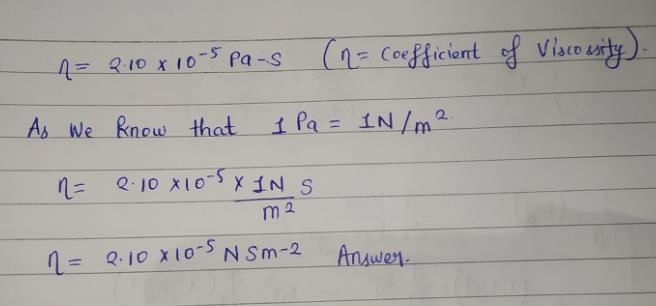Chemistry Exam > Chemistry Questions > The coefficient of viscosity of a species is ...
Start Learning for Free
The coefficient of viscosity of a species is 2.10x 10-5 Pa-s. This value is also equal to
- a)2.10 x 10-5 Nm-2s
- b)2.10 x 10-6 kg m-1s-1
- c)2.10 x 10-7 poise
- d)All of these
Correct answer is option 'A'. Can you explain this answer?
Most Upvoted Answer
The coefficient of viscosity of a species is 2.10x 10-5 Pa-s. This val...

Hence Option A is correct
Free Test
FREE
| Start Free Test |
Community Answer
The coefficient of viscosity of a species is 2.10x 10-5 Pa-s. This val...
Understanding Viscosity
Viscosity is a measure of a fluid's resistance to flow. It quantifies how much a fluid will deform under shear stress.
Coefficient of Viscosity
- The coefficient of viscosity (η) is typically expressed in units of Pa·s (Pascal-seconds).
- In the given problem, the coefficient of viscosity is 2.10 x 10^-5 Pa·s.
Relation to Other Units
- Nm^-2s:
- 1 Pa = 1 N/m², so 1 Pa·s = 1 N·s/m².
- Therefore, 2.10 x 10^-5 Pa·s is equivalent to 2.10 x 10^-5 N·m^-2·s.
- This confirms option (a) is correct.
- kg m^-1s:
- Viscosity can also be expressed in kg/(m·s).
- 1 Pa·s = 1 kg/(m·s) because 1 N = 1 kg·m/s², leading to the same dimensional analysis.
- Thus, 2.10 x 10^-5 Pa·s is also equal to 2.10 x 10^-5 kg·m^-1·s, making option (b) potentially correct.
- Poise:
- The poise is a unit of dynamic viscosity in the centimeter-gram-second (CGS) system.
- 1 poise = 0.1 Pa·s, so 2.10 x 10^-5 Pa·s = 2.10 x 10^-6 poise, indicating option (c) is also valid.
Conclusion
- While the statement indicates option (a) as the correct answer, both (b) and (c) are mathematically valid representations of viscosity.
- Therefore, the correct interpretation is that all options have valid equivalences, but the primary focus here is on option (a) as the standardized unit in the SI system.
Viscosity is a measure of a fluid's resistance to flow. It quantifies how much a fluid will deform under shear stress.
Coefficient of Viscosity
- The coefficient of viscosity (η) is typically expressed in units of Pa·s (Pascal-seconds).
- In the given problem, the coefficient of viscosity is 2.10 x 10^-5 Pa·s.
Relation to Other Units
- Nm^-2s:
- 1 Pa = 1 N/m², so 1 Pa·s = 1 N·s/m².
- Therefore, 2.10 x 10^-5 Pa·s is equivalent to 2.10 x 10^-5 N·m^-2·s.
- This confirms option (a) is correct.
- kg m^-1s:
- Viscosity can also be expressed in kg/(m·s).
- 1 Pa·s = 1 kg/(m·s) because 1 N = 1 kg·m/s², leading to the same dimensional analysis.
- Thus, 2.10 x 10^-5 Pa·s is also equal to 2.10 x 10^-5 kg·m^-1·s, making option (b) potentially correct.
- Poise:
- The poise is a unit of dynamic viscosity in the centimeter-gram-second (CGS) system.
- 1 poise = 0.1 Pa·s, so 2.10 x 10^-5 Pa·s = 2.10 x 10^-6 poise, indicating option (c) is also valid.
Conclusion
- While the statement indicates option (a) as the correct answer, both (b) and (c) are mathematically valid representations of viscosity.
- Therefore, the correct interpretation is that all options have valid equivalences, but the primary focus here is on option (a) as the standardized unit in the SI system.

|
Explore Courses for Chemistry exam
|

|
Question Description
The coefficient of viscosity of a species is 2.10x 10-5 Pa-s. This value is also equal toa)2.10 x 10-5 Nm-2sb)2.10 x 10-6kg m-1s-1c)2.10 x 10-7poised)All of theseCorrect answer is option 'A'. Can you explain this answer? for Chemistry 2025 is part of Chemistry preparation. The Question and answers have been prepared according to the Chemistry exam syllabus. Information about The coefficient of viscosity of a species is 2.10x 10-5 Pa-s. This value is also equal toa)2.10 x 10-5 Nm-2sb)2.10 x 10-6kg m-1s-1c)2.10 x 10-7poised)All of theseCorrect answer is option 'A'. Can you explain this answer? covers all topics & solutions for Chemistry 2025 Exam. Find important definitions, questions, meanings, examples, exercises and tests below for The coefficient of viscosity of a species is 2.10x 10-5 Pa-s. This value is also equal toa)2.10 x 10-5 Nm-2sb)2.10 x 10-6kg m-1s-1c)2.10 x 10-7poised)All of theseCorrect answer is option 'A'. Can you explain this answer?.
The coefficient of viscosity of a species is 2.10x 10-5 Pa-s. This value is also equal toa)2.10 x 10-5 Nm-2sb)2.10 x 10-6kg m-1s-1c)2.10 x 10-7poised)All of theseCorrect answer is option 'A'. Can you explain this answer? for Chemistry 2025 is part of Chemistry preparation. The Question and answers have been prepared according to the Chemistry exam syllabus. Information about The coefficient of viscosity of a species is 2.10x 10-5 Pa-s. This value is also equal toa)2.10 x 10-5 Nm-2sb)2.10 x 10-6kg m-1s-1c)2.10 x 10-7poised)All of theseCorrect answer is option 'A'. Can you explain this answer? covers all topics & solutions for Chemistry 2025 Exam. Find important definitions, questions, meanings, examples, exercises and tests below for The coefficient of viscosity of a species is 2.10x 10-5 Pa-s. This value is also equal toa)2.10 x 10-5 Nm-2sb)2.10 x 10-6kg m-1s-1c)2.10 x 10-7poised)All of theseCorrect answer is option 'A'. Can you explain this answer?.
Solutions for The coefficient of viscosity of a species is 2.10x 10-5 Pa-s. This value is also equal toa)2.10 x 10-5 Nm-2sb)2.10 x 10-6kg m-1s-1c)2.10 x 10-7poised)All of theseCorrect answer is option 'A'. Can you explain this answer? in English & in Hindi are available as part of our courses for Chemistry.
Download more important topics, notes, lectures and mock test series for Chemistry Exam by signing up for free.
Here you can find the meaning of The coefficient of viscosity of a species is 2.10x 10-5 Pa-s. This value is also equal toa)2.10 x 10-5 Nm-2sb)2.10 x 10-6kg m-1s-1c)2.10 x 10-7poised)All of theseCorrect answer is option 'A'. Can you explain this answer? defined & explained in the simplest way possible. Besides giving the explanation of
The coefficient of viscosity of a species is 2.10x 10-5 Pa-s. This value is also equal toa)2.10 x 10-5 Nm-2sb)2.10 x 10-6kg m-1s-1c)2.10 x 10-7poised)All of theseCorrect answer is option 'A'. Can you explain this answer?, a detailed solution for The coefficient of viscosity of a species is 2.10x 10-5 Pa-s. This value is also equal toa)2.10 x 10-5 Nm-2sb)2.10 x 10-6kg m-1s-1c)2.10 x 10-7poised)All of theseCorrect answer is option 'A'. Can you explain this answer? has been provided alongside types of The coefficient of viscosity of a species is 2.10x 10-5 Pa-s. This value is also equal toa)2.10 x 10-5 Nm-2sb)2.10 x 10-6kg m-1s-1c)2.10 x 10-7poised)All of theseCorrect answer is option 'A'. Can you explain this answer? theory, EduRev gives you an
ample number of questions to practice The coefficient of viscosity of a species is 2.10x 10-5 Pa-s. This value is also equal toa)2.10 x 10-5 Nm-2sb)2.10 x 10-6kg m-1s-1c)2.10 x 10-7poised)All of theseCorrect answer is option 'A'. Can you explain this answer? tests, examples and also practice Chemistry tests.

|
Explore Courses for Chemistry exam
|

|
Signup for Free!
Signup to see your scores go up within 7 days! Learn & Practice with 1000+ FREE Notes, Videos & Tests.


















